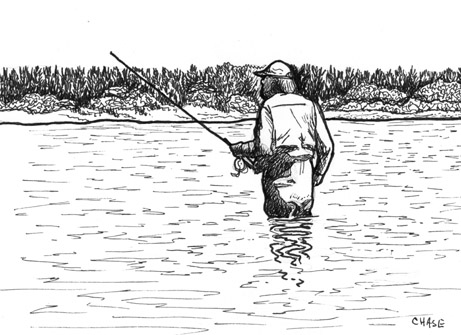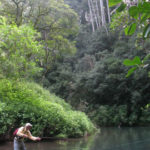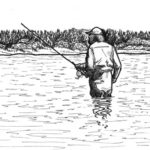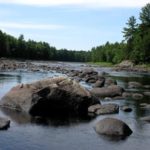BOOK EXCERPT–
This wasn’t good. I was coughing and spitting water, and I could see blood—mine– below the surface…
Let’s start at the beginning. It was late summer on Lake Michigan years ago. My wife and I had reached the lake shore via a little county road in Hiawatha National Forest. From there we tossed our beat up, though trusty, aluminum canoe in the water and loaded it up with our camping gear. This big bay of the mighty lake was surprisingly calm, so the 2-mile paddle along the shoreline to a long stretch of grassy and sandy beach was easy and enjoyable. In many respects this shoreline was an excellent camping spot, since this part of the lake had several miles of wild, undeveloped land administered by the Forest Service. And at that time, they still allowed primitive camping right on the beach. By midafternoon we had picked out a fine spot covered with grass and low bushes where we put up the tent and small camp chairs, rolled out our sleeping bags and even heated up a late lunch using the Coleman stove.
Lyn was interested in exploring the diverse flowering flora that grew along the shoreline, but naturally my thoughts had turned to bronze. In fact, on the paddle to our campsite I’d noticed small darker-colored patches of rock scattered in the bright sand bottom. These were visible for hundreds of yards out from shore. (Many shorelines on the northern side of Lake Michigan are exceptionally shallow; depths can be just four feet even a quarter-mile out from land.)
Grabbing my 7-foot medium-action spin stick and a few lures in a small tackle bag, I headed back down the shoreline for half a mile to where I had noticed the most rock. It was late August and both the air and water temps were in the 70s. So very nice for wade fishing, and this was back when I often waded in only shorts and sneakers (we still called them tennis shoes then). There were several clusters of rubble about 3 feet deep one hundred fifty yards out, and I worked 3 or 4 spots without a strike. So I figured because the water was clear and it was still sunny that deeper rocks would be more productive. I could see more dark patches farther from shore, so deeper I went. I was now waist-deep, and 60 or 70 feet farther out were a couple more rock patches, each no bigger than a living room rug. I fired a bigger Rapala towards the closest rubble, gave it a couple cranks and bingo! A chunky 14-incher shot out of the water just a few seconds after I set the hook. After a spirited tussle and a couple more jumps I brought that fish to hand. Moving a little farther, I could reach another cluster of rock. I stuck with the trusty Rapala and only 2 or 3 casts later was rewarded with another strike. This was a 12-incher but still a fine fish that jumped repeatedly in that warm water. Then after several more casts I hooked and lost a smaller bronzeback (actually these clear-water fish were quite light, more like “greenbacks”).

With no further action in these rocks, my angler optimism convinced me that far more and much bigger fish likely lay in even deeper water. The next dark patches I could see seemed quite a ways farther out. But heck, the water was warm, my tackle bag had already been submerged and I had long legs. Though I was over my waist and over 300 yards from dry land, my targets were still well out of range. Undeterred, I continued deeper, doing the “waders shuffle” (sliding one foot forward close to the bottom while the other trailed behind). Even though I was now chest deep and I was holding my rod over my head, I figured just a little farther and I could reach the rocks with a long cast. The last 15 yards was slow going (wading isn’t that easy when it’s nearly 5 feet deep), but I was now close enough. Good casting with your rod, reel and arms high over your head is a little tricky, but after a couple attempts the plug landed pretty close to where I wanted it to go.
No luck, and perhaps worse, a southern breeze had come up and was creating a slight chop on the surface. I was so deep that the higher waves nearly gave me a mouthful of water. But keeping my mouth shut on the upswells, I kept casting.
Five or six long casts later I got a hard yank. It stayed down for awhile and I was convinced it was a dandy. Then about halfway back it made a high jump and I could see it was probably 14 or 15 inches. While not a monster, it was a fine specimen and I was happy my efforts had finally paid off. After powering hard to the left, then the right, the smallie seemed to come right towards me. Cranking in line as fast as possible, I just got tightened up when I saw the fish coming fast past my right side. Tightening down a little more, and suddenly the greenback changed directions again and yeow! A searing pain in my right calf.
As the fish shot past me it drove one of the lure’s hooks into my leg. The 4 3/8th– inch Rapala has three trebles and it seemed like most of them were now in me. Worse, the smallie was still attached and it wasn’t done fighting. Yanking away violently, each yank felt like the hooks were being driven deeper into my leg.
Instinctively reaching down with one hand towards my throbbing leg, I quickly realized my lower calf was a far below the surface and I wasn’t going to get the hooks out easily. Sputtering and coming back up for air, I saw the bright red blood oozing out of my leg. “This ain’t good, Tim.” I thought to myself. Trying to wade way back to land was out of the question, and my leg hurt like the dickens. I had to do something fast. Lifting my hooked leg off the bottom so I could reach it, I staggered on one foot and nearly fell over, and my head went below the surface. Sputtering for air, I went back to the two-foot stance and decided to try another tactic. Holding my rod in one hand I took a deep breath and bent over so I could reach the lure/fish with the other hand. But that didn’t work either. The fish and plug were flailing next to my leg and I couldn’t get a hold of the smallmouth with just one hand without impaling another appendage. Coming back up for air, I decided to drop my rod so I could use both hands. Another big breath and down I went again. Now I got a grip on the fish and managed to remove the tail trebles he was attached to. While likely not pleased with his first human leg encounter, the smallie immediately darted into the depths. But I was still attached to the lure.
Coming up for air yet again, I knew my next dive would be the most painful. Catching my breath for a couple minutes, I squinted into the water to study my predicament. Fortunately, just one hook was in my calf and there wasn’t any more blood trail. So one more time I plunged my head underwater and grabbed both my leg and lure. Sort of pinching my calf while holding the offending treble I gave it a hard yank. “A w o u c h!!” But the Rapala was free.
Surprisingly, the pain wasn’t too bad now. I guess my leg had finally gotten numb after ten minutes of hurting. I pulled on the length of line and the rod rose close enough to grab. The reel was full of water, of course, but after shaking it, I turned the handles. It seemed sand hadn’t gotten into the gears, so I had functioning tackle again. One hook on the plug was bent from the rough bass extraction, but the lure, too, was functionable. Looking to the distant shoreline, then towards another rock patch to my left, I thought. What the heck, I’m not bleeding much, there’s still daylight and I know that dang Rapala definitely works. So out it went towards the next rock pile. And wouldn’t you know, I caught 3 more nice smallies on that lure before the setting sun told me to start the long wade back to dry land. When Lyn asked, how was the fishing, I just said “not bad, I hooked some good ones.”
— Excerpted from the book “Adventures of a Fishing Bum — 27 True Tales.”
Read More Adventure Tales:






Wow, what a tale. I want to buy the book.